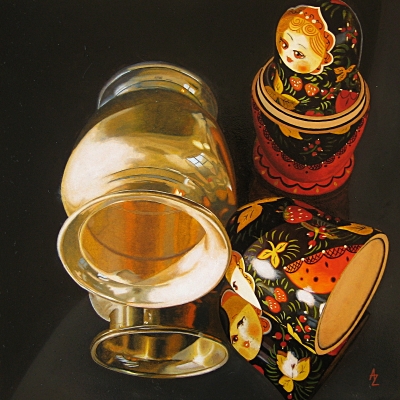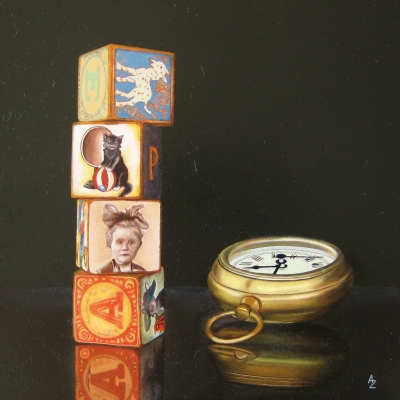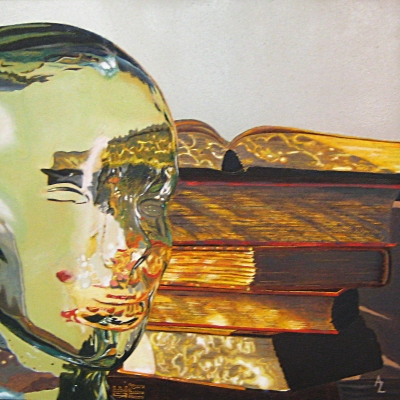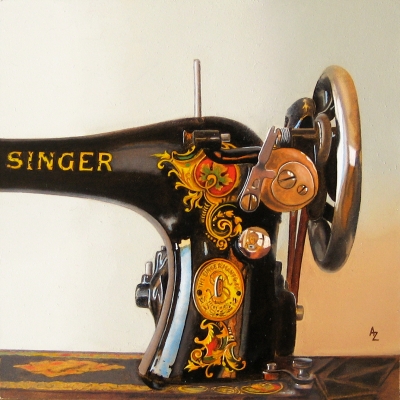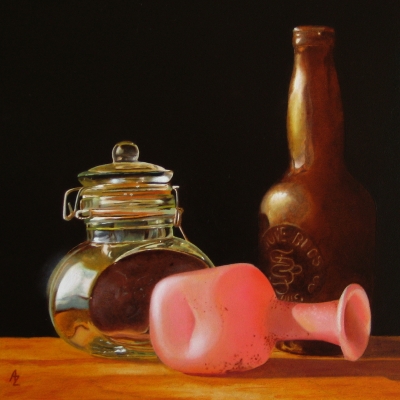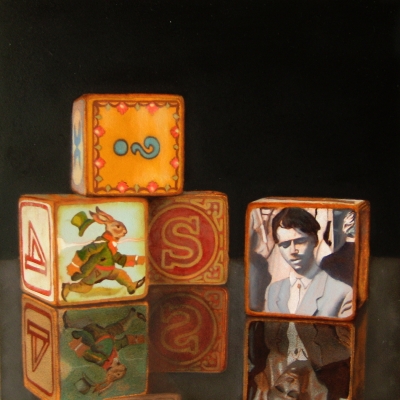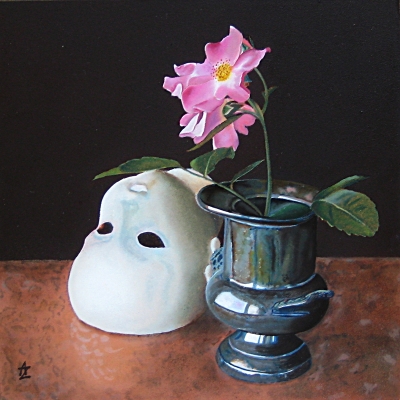Posts Tagged: painting
A Dream within a Dream
8″ x 8″ (20 x 20 cm) oil on gessobord panel. To bid on this painting click here.
The painting was slow in coming, and I am not all sure why it took so long. I started it before Christmas. So OK, there was Christmas with all its Christmasy chores, then there was the New Year and a pressure to party, then Shelly went on her epic Israeli trip. Where did the time go…
I am doing a small series under a working title Reflections. The idea is to connect memories with images reflecting in a mirror. I am working on another painting along these lines that is nearly finished.
In this one I hoped to connect to my former country. I tried to work out the anger I still feel even now, almost a quarter of century since I left. When I try to be rational I can come up with things that were good back then, 25 years ago, but list is rather short. I remember being young was fun, ahh… good times we had! Love Russian art, poetry, and music. Hmmm… love how mathematics was taught… Love my memories of hiking, sailing and amazing natural beauty. That’s about it. My other list – the “angry” one – is long and ugly, full of injustice, KGB and empty grocery stores.
The credit for the title of this painting goes to my daughter Shelly. Thank you, Shelly, it was brilliant!
BFFs
Best Friends Forever… Katya and Colin.
8″ x 8″ (20 x 20 cm) oil on gessobord panel. To bid on this painting click here.
In spite her youthful appearance Katya is an old gal. She is 19, almost 20. We all remember vividly how Katya came to live with us. That summer Shelly was 3 and had to go see her doctor for a checkup. For some unfathomable or since forgotten reason the doc decided that Shelly’s ears needed to be washed inside with warm water applied from a large syringe. Shelly took exception to the proceedings. Her wailing could have drowned an ambulance siren. She was still voicing her objections and indignation when we left the torture chamber, I mean – the doctor’s office, and got in a car. Instead of going home I drove straight to Toys-R-Us. Grandma and I knew that we found a soul mate as soon as we saw Katya. The drama and tears stopped in an instant, and Shelly was smiling. Katya lived with us ever since and helped us through many illnesses and medical procedures.
Colin came much later. My memory of Shelly’s early teen years is fairly vague. I understand that the psyche does this for a reason, for our own benefit some things better remain obscured and misted over. I don’t object. But at some point during those fog clouded years Colin arrived and took a place of honor on the bed, next to Katya and Francisco.
Oh, should I tell you about Francisco? Later, perhaps… when I paint him.
Memory Blocks III
A new installment for my Memory Blocks series. This time it is with my mom’s portrait at the age of 5.
8″ x 8″ (20 x 20 cm) oil on gessobord panel. To bid on this painting click here.
I’ve found interesting articles about photorealism and hyperrealism on Wikipedia:
Photorealism
Hyperrealism.
While the articles are very informative, with lots of links, examples and images, they didn’t articulate clearly the difference between the two styles. Seeing that the terms are often used interchangeably I wanted to define the deference for myself. Here’s what I came up with:
The beginnings of Photorealism are placed at 1960 – 1970. It is a method of painting that uses a photograph as a reference and takes this reference literally. The painted image is extremely well defined and detailed. All information available about the subject is rendered in the painting. The rendering is tight and very accurate. Emotional processing and creating of a narrative are left to the viewer’s imagination.
It was clear from the articles above that Hyperrealism as a genre has originated in Photorealism at about 2000. In difference to its originating genre Hyperrealism takes the image to a surreal plain to some extent. The painter paints everything he or she sees to the maximum degree of accuracy that the skill and medium allows… and then the artist takes the image further, creating more clarity and definition than the reference had. For example, if some details were dimmed in a shadow or bleached in a strong light, the artist reinvents them and puts them in. The resulting image simulates a reality that did not exist and crosses into the territory of illusion.
Clarity
As if one empty head was not enough, I got myself another. I came across this glass mannequin head – which is supposed to be a hat holder – in Pier I and had to have it. And paint it. I hear “two heads are better than one” everywhere, so maybe there is hope.
The glass head is life size, and I paired it with a stack of old books – the ultimate clarity. I couldn’t resist the distortions and play of light the glass creates. The title – Clarity – is of course a play of words and a bit of a mockery: the resulting painting, while rendered in realistic tradition, contains surprisingly abstract shapes and patterns.
6″ x 6″ (15 x 15 cm) oil on gessobord panel. To participate in an auction and perhaps acquire an empty head for yourself 🙂 – click here.
![]()
Singer
I had this magnificent old Singer forever. So long that I don’t even remember where it came from. I think I found it in the basement of the house I bought 20 years ago, but i can’t be certain. The house is long sold and forgotten, but I kept the sewing machine – what an amazing piece of design! They literally don’t make them like this any more.
This particular Singer numbered G9848954 – Model 127 “vibrating shuttle”(long bobbin) – was built in USA between 1921 and 1923 according to the records meticulously kept by Singer Manufacturing Co. Probably closer to the end of the range judging by its number. The machine still works, but I have a new contemporary electric Singer for what little sewing I do these days. This one is to admire and paint. A piece of history.
6″ x 6″ (15 x 15 cm) oil on gessobord panel.
Handle with Care
A brand new clear jar from Whole Foods, an old brown bottle found on a construction site and a Murano glass vase from Venice – a delightful glass world. I must be part crow – I love glass! Now that I don’t weave with glass, I paint it, just can’t keep away from it. The play of light in glass enchants me.
6″ x 6″ (15 x 15 cm) oil on gessobord panel. To buy this painting click here.
On September 6 this blog Pencil Scribbles turned two years old! I briefly thought of doing a separate post about it, but it didn’t seem important enough for a dedicated post. But it does deserve a mention. During its two years
29 213 times people viewed something on these pages
1267 comments were left
115 different countries visited and left a flag on my map
106 times I made a piece of art or had something to say!
Here’s to you, my friends – old and new!
Memory Blocks II
Just finished another Memory Blocks painting. The block on the right is my father Shimon circa 1961 or thereabouts. I have to ask him when exactly this photo was taken. These blocks are a blast to paint. I made them new and shiny at first, then aged them and felt like a Master of Time.
6″ x 6″ (15 x 15 cm) oil on gessobord panel
Le Gallery Thorndale
Today I took these six paintings to their first show at Le Gallery Thorndale. Le Gallery Thorndale is a local gallery sponsored by Chicago Edgewater Chamber of Commerce.
From gallery’s press release:
Le Gallery Thorndale is a limited-time, exclusive art exhibit organized by Edgewater Artists in Motion as part of its ongoing effort to make Chicagoans explore Edgewater as an eclectic artistic community and a vibrant creative force in our city.
Location: 1106 West Thorndale Ave, Chicago IL 60660
Opening: Friday September 2, 5:30 – 8:30 pm
Show dates: September 2 – September 30
Gallery Hours: Friday – 4 pm to 7 pm, Sat and Sun – 11 am to 4 pm
If you are in Chicago, join me, other artists and art collectors for the opening night on Friday, September 2, 5:30 – 8:30 pm.
Noh
I borrowed this Venetian porcelain doll head from my art teacher. It made me think of Japanese mask theater. It took a while to come with a composition that made the idea clear. Finally, a little pink wild rose from a bush up my street did it. I am not much for painting flowers, but it was perfect.
I had a lot of trouble painting this still life. For the sake of experiment I did the underpainting in Prussian Blue. The thought of Michelangelo’s blue/green underpainting was on my mind. A mistake. Prussian Blue is such a cold tone. It took me the better of two weeks to warm this up. But oil is so forgiving. It let me warm up the parts I wanted warm and keep the vase cool and crisp. Then I struggled with the flower. As I said – flowers are not my thing, I didn’t even have pigments suitable for flowers. Trying to mix cool and hot pink based on Alizarin Crimson was a loosing battle. I had to go and buy quinacridone magenta, and then borrow a smidgen of quinacridone violet, and that did it. And what in world possessed me to choose the vase that has 9 ellipses? I must be a glutton for punishment. I tweaked and corrected the darned ellipses until the thought of switching to abstract painting style settled prominently in my head.
The moment when I finally painted my initials was a real victory.
6″ x 6″ (15 x 15 cm) oil on gessobord panel.
Sentries
Trying to figure out techniques of Old Masters I chose a simple composition and dramatic light. I am mesmerized by chiaroscuro effect (a contrast of light and dark) in the old paintings and especially Caravaggio. It has proven to be very hard to find a good detailed description of oil glazing method the way they did it back then. I read numerous books containing sparse and cryptic outlines, and as a result tried a sequence of steps that some authors attribute to Caravaggio himself, others call it the Dutch or Flemish technique used by Jan van Eyck and his contemporaries.
I planned to document each step, but it didn’t work that way. I would get all caught up painting and forget to stop and photograph various stages. But I have the main steps captured.
I did a detailed charcoal drawing of my still life on gessobord. I fixed the charcoal with workable fixative and let it dry. Then I covered the entire surface with initial oil layer called Imprimatura. I used Burned Sienna for that because of the fast drying properties of oil earths and to create warm undertones. I let that dry completely.
The next stage was Grisaille underpainting. This is a monochromatic painting, basically a grayscale to establish values, and is done using lean oils in dark and white. It is sometimes called Dead Layer. Or when it is done with an earth color, like I did here using Burnt Umber, it is called Verdaccio.
It is a very important step and has to be done just right because it is hard to fix values later. I spent a lot of time here. Then I let it dry for several days.
Now it was time to bring in color glazes. I had a bunch of trouble here because I couldn’t figure out my glazing medium. I tried using my general Galkid Lite oil medium, but it was too thick and viscous to spread out the way I wanted. I got another medium recommended in one of my books, but it gave me a blindingly shiny paint film, so sparkly that I thought I’d have to junk this painting. Finally I tried a very liquid medium, practically a plain linseed oil, and it worked. While I was struggling with my medium problem I stopped taking photos because I thought I would have to abandon this painting and start over. The photo above was taken when I managed to quiet down the shine.
It didn’t take many glazes to get to the final values, maybe 4 or 5. Probably because I spent all this time with my Grisaille layer, and my values were well defined. At this point the painting was pretty much painting itself. When I got close to completion I added details, dots and imperfections on the pears’ skin, deepened the background and painted the texture on the wooden box. Then I added one more glaze of colors to the pears to unify everything. Finally I painted the last glaze of pure medium to even out the sunken areas. Finito!
Many of my friends and family are of the opinion that I should start marketing my work. These little painting tiles are perfectly sellable, they say. I finally gave in and after some research and oscillation chose an online gallery Daily Paintworks. Check it out for many wonderful original paintings and an amazingly talented group of artists. I am happy to be in such a great company! Here’s the beginning of my galleryon the Daily Paintworks site.
6″ x 6″ (15 x 15 cm) oil on gessobord panel.

